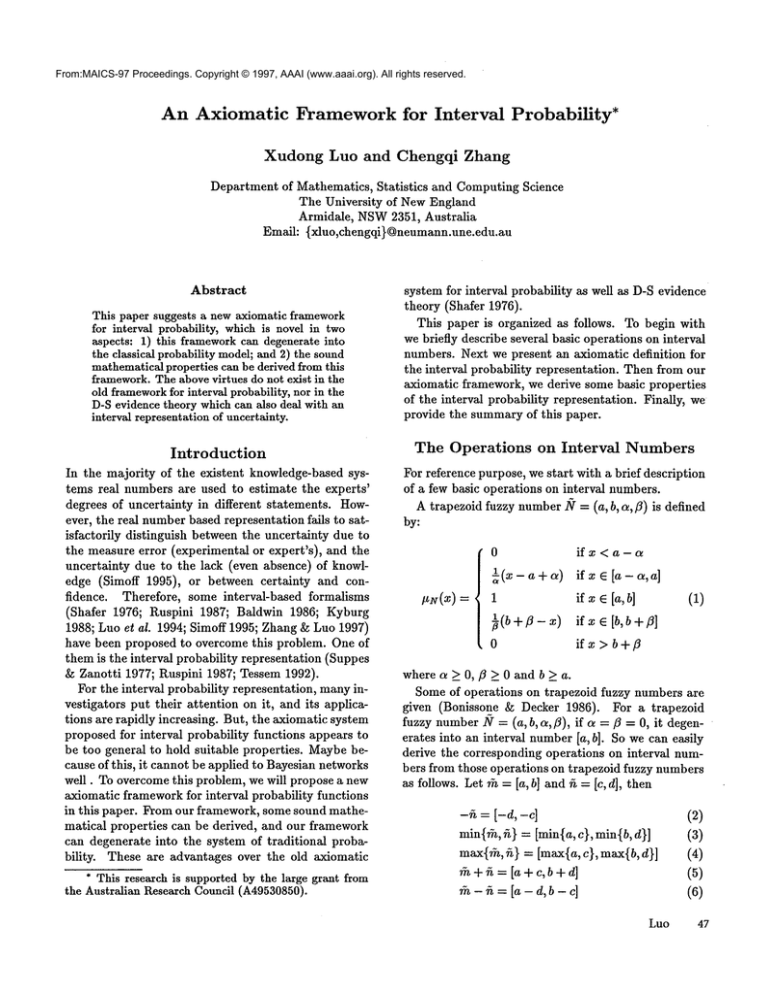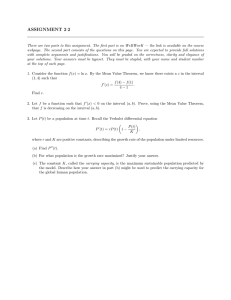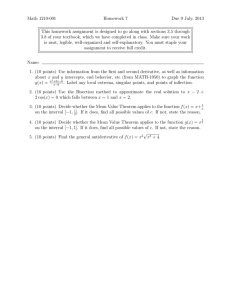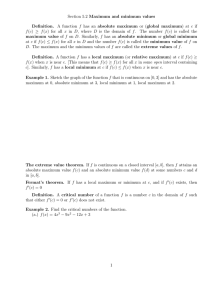
From:MAICS-97 Proceedings. Copyright © 1997, AAAI (www.aaai.org). All rights reserved.
An Axiomatic Framework for Interval
Probability*
Xudong Luo and Chengqi Zhang
Department of Mathematics, Statistics
and Computing Science
The University of NewEngland
Armidale, NSW2351, Australia
Email: {xluo,chengqi}@neumann.une.edu.au
Abstract
This paper suggests a new axiomatic framework
for interval probability, which is novel in two
aspects: 1) this frameworkcan degenerate into
the classical probability model;and 2) the sound
mathematicalproperties can be derived from this
framework.The abovevirtues do not exist in the
old frameworkfor interval probability, nor in the
D-Sevidence theory which can also deal with an
interval representation of uncertainty.
Introduction
In the majority of the existent knowledge-based systems real numbers are used to estimate the experts’
degrees of uncertainty in different statements. However, the real numberbased representation fails to satisfactorily distinguish between the uncertainty due to
the measure error (experimental or expert’s), and the
uncertainty due to the lack (even absence) of knowledge (Simoff 1995), or between certainty and confidence. Therefore, some interval-based formalisms
(Shafer 1976; Ruspini 1987; Baldwin 1986; Kyburg
1988; Luo et al. 1994; Simoff 1995; Zhang & Luo 1997)
have been proposed to overcome this problem. One of
them is the interval probability representation (Suppes
& Zanotti 1977; Ruspini 1987; Tessem 1992).
For the interval probability representation, manyinvestigators put their attention on it, and its applications are rapidly increasing. But, the axiomatic system
proposed for interval probability functions appears to
be too general to hold suitable properties. Maybebecause of this, it cannot be applied to Bayesian networks
well. To overcome this problem, we will propose a new
axiomatic frameworkfor interval probability functions
in this paper. From our framework, some sound mathematical properties can be derived, and our framework
can degenerate into the system of traditional probability. These are advantages over the old axiomatic
* This research is supported by the large grant from
the Australian Research Council (A49530850).
system for interval probability as well as D-S evidence
theory (Shafer 1976).
This paper is organized as follows. To begin with
we briefly describe several basic operations on interval
numbers. Next we present an axiomatic definition for
the interval probability representation. Then from our
axiomatic framework, we derive some basic properties
of the interval probability representation. Finally, we
provide the summaryof this paper.
The Operations
on Interval
Numbers
For reference purpose, we start with a brief description
of a few basic operations on interval numbers.
A trapezoid fuzzy number/~-= (a, b, a, r) is defined
by:
0
l(x-a+a)
1
~(b+fl-x)
0
ifx
<a-or
ifxe[a-a,a]
if x E [a, b]
(1)
ifxE[b,b+fl]
ifx > b+fl
where a k 0, fl >_ 0 and b > a.
Someof operations on trapezoid fuzzy numbers are
given (Bonisson_e & Decker 1986). For a trapezoid
fuzzy number N = (a,b,a, fl), if a = fl = 0, it degenerates into an interval number[a, b]. So we can easily
derive the corresponding operations on interval numbers from those operations on trapezoid fuzzy numbers
as follows. Let rh = [a, bI and ~ = [c, d], then
-~ = [-d,-c]
min{vh,
~}=[min{a,
c}, min{b,
d}]
max{~h,
~,} = [max{a,
c}, max{b,
d}l
Kn+ ~=[a +c,b+ d]
- ~ =[a - d, b- c]
Luo
(2)
(3)
(4)
(5)
(6)
47
[ac, bd] if~h>O,~>O
ff~ x ~ =
[ad, bc] ifrh<O,~>O
[bc, ad] ifrh>O,~<O
[bd, ac] ifzh<0,~<0
rh+~=
f~,~]
ifrh>0,~>0
[~,~]
if rh < 0,g > 0
{
[-~, ~] ifrh > 0,7~ < 0
(s)
Note that in the above last two formulas, the concepts
that an interval number is greater or less than 0 are
used. In fact, for any interval number[a, b], [a, b] > 0
iff Vxe [a, b], x > 0; [a, b] < 0 iff Yx¯ [a, b], x < 0.
Whentwo ends of a interval number are equal, it
degenerate into a real number. Hence, from formulas
(7) and (8), we easily get the fonowing formula:
a ×[c, d]=[ac,ad]
ab
[a,~]+c= [c’
~]
(9)
(10)
In the next section, we shall propose an axiomatic
framework for interval representation or proDaDnl~y.
Then when deriving some basic properties for the
frameworkfor interval probability, we will mainly exploit formulas (9) and (10). Maybeother operations
interval numbers will be employed in further study on
properties of our system for interval probability, and
therefore we list all of them here.
The Axiomatic Frameworkfor Interval
Probability
In this section, we will give an axiomatic system for
interval probability. In the past investigators also gave
an axiomatic system for interval probability (Chrisman 1996). But it is more general at additivity than
ours. Unfortunately, this seems to lead that some
sound mathematical properties are difficult to be derived from this old framework. Another advantage of
our system is that it can degenerate to the axiomatic
system for classic probability.
Sometimes,it is difficult to supply an exact estimate
for the value of a probability P, yet it is relatively easy
to provide a pessimistic estimate P and an optimistic
estimate P for this value. In other words, at this moment we offer an interval for the probability, namely,
P = [P, P].
The question is which properties interval-based
probability should satisfy. Since we estimate probabilities sometimes by real numbers and sometimes by
interval numbers, maybeprobabilities in the two forms
48
MAICS-97
are operated at the same times. Accordingly, the axiomatic system for interval probability should degenerate into that for real-valued probability. The key to
problem is howto express additivity of interval probability, so that when upper boundary and lower boundary of interval probability are equal, the additivity
can degenerate into the additivity of point probability. Based on such a consideration, we propose the
following axiomatic system for interval probability.
Definition 1 Let (f~,Yr) be a probability space, and
let P___, -P: yr , [0, 1] be set-functions on this space
satisfying the following properties for any A, B ¯ Jr
with A f3 B = O:
~. ~(~)= T(0)=
2. P(~)= ~(~)
3. P__(A U B) = min{P(A) -P(B),P(B) + P( A)}
4. P(A U B) = max{P__(A) + P(B), P(B)
Then P and P are called lower and upper probability functions respectively, rt is always the case that
P(A) < -P(A).
~.~ the -~ .... ~":’:"" ~roperties 3 and 4 specify
a sort of additivity for interval probability. In point
probability system, the additivity is specified as follows:
P(A U B) = P(A) + P(B)
(11)
where A, B C ~t with AnB = 0. Clearly,
when
P = _P, the additivity in our system for interval probability can degenerate into the one for point probability. Andnoticing properties 1 and 2 in Definition 1,
we can conclude our system for interval probability can
degenerate into the system for point probability.
Nowlet us examine the old axiomatic system for
interval probability as follows (Chrisman 1996):
1. p_(0)= ~(0)
2. p__(a)= ~(a)
3. P(A) + P(A)
4. P(A) + P(B) < P(A U B) (Super-additivity)
5. P(A) + P(B) <_ P(A (S ub-additivity)
whereA,
BcflwithAnB=0.
Clearly, there are the difference in additivity between the two systems. The additivity in our system
is expressed by equations, whereas the one in old system is represented by inequalities. For the relationship
between them, we have the following obvious theorem:
Theorem 1
1. If P(A U B) = min{P(A) + P(B), P(B)
then P(A) + P(B) <_ P(A U B)
2. If P(A IJ B) = max{P(A) -f i(B),P(B) +
then -P(A) + -P(B) <_ -P(A
P( A)},
This theorem states that the old system for interval
probability is more general at additivity than ours. But
it seems not to be a good thing. The definition of
additivity is vital for us to derive sound mathematical
properties. In fact, if it is too general it cannot reveal
some sound mathematical properties. Intuitively, from
the additivity expressed by inequalities it is difficult to
derived some mathematical properties. Instead, it is
easy to derive from our system because ours is not so
general. Wewill see this fact in the following section.
In addition, when P = P, our system degenerates
into the classic probability axiom, but this property
does not exist in the old systemfor interval probability.
This is because when P = P, both super-additivity and
sub-additivity turn to the following inequality:
P(A) + P(B) <_ P(A
yet we cannot derive (11) from the above inequality.
Theorem
2
P(A) + P(A)
P(A) + P(A)
(12)
(13)
Moreover, Theorem 2 exposes that the relationship
between our system and D-S evidence theory. In DS evidence theory, the uncertainty of a proposition A
is assessed by an interval [Bel(A), Pl(A)]. The lower
boundary, called the belief, represents the degree to
which the evidence supports this proposition, while the
upper boundary, called the Plausibility, denotes the degree to which the evidence fails to refute the proposition, namely the degree to which it remains plausible.
The relationship between the belief function and the
plausibility function is as follows:
Pl(A) = 1 - Bel(A)
(14)
that is,
PI(A) + Bel(-A)
= 1
(15)
Comparing (15) and (13), we can see that P(A)
pears to be equivalent to Bel(-A), and P(A) appears
to be equivalent to PI(A). The most important characteristic of D-S evidence theory is that it is able to
represent the ignorance because the following inequality:
Bel(A) + Bel(-A) < 1
(16)
Our system for interval probability can also represent
the ignorance because a similar property also holds in
our system for interval probability. In fact, we have
the following theorem:
Theorem
3
P(A) + P(A)
(17)
Proof.
Proof.
P(A)+ P(A-)
1
< P(A U-A)
= P(a)
= P(Au ])
= min{P(A) + P(A),P(A)
= 1
1)
[]
In short, our system for interval probability can do
what D-S evidence theory can do. Rather, unlike our
system for interval probability but like the old system
for interval probability, clearly D-S evidence theory
fails to degenerate into the system for point probability, and somesound mathematical properties are difficult to be derived from the axiomatic system for D-S
evidence theory, which is as follows.
P( A)}
Thus, we have
1 < P(A)+P(A)
1 < P(A) + P(A)}
So, the theorem holds,
(by property 2 in Definition
+
Similarly, we have
1 = max{P(A) P(A),P(A) +
(by Theorem 1)
=
o
Theorem2 states that the additivity in our system
for interval probability can imply property 3 in the old
system. Consequently, Theorems 1 and 2 state that
our system for interval probability is not contradictory
to old one.
1. Bel(O) =
2. Bel(a)=
3. Sel(A1 U... U An) >_ ~=i Bel(Ai)
" ~,j:i_<i<j_<,, Bel(Ai VI Aj) +...
+ (-1)n+iSel(At N... N
Luo
49
for every positive integer
A1,’" ,An of subsets of ~.
Basic Properties
In this section we will examinesome of the basic properties of our interval probability function. Wecan easily see that these properties are the extension of the
corresponding ones in classic probability theory.
Definition 2 The interval conditional
P(AIB) is defined as follows:
[1,1]
3) Additivity
P(A1 U A~IB)
P((A1 U A2) n B)
P(B)
P((A1 n B) u (A2 n B))
probability
P(AIB) P( A M B)
P(B)
(18)
that is,
.P(AMB)
P(AnB)
= [---P-(B]
’ P(B) ] (19)
[P(AIB)"-fi(AIB)]
P(B) P(B)]
P(B)’P(B)’
because P(B) = P(B)= P(B))
n and every collection
where P(B) 6 (0, 1].
Clearly, the definition is consistent with that in classic probability theory. The following theorem shows
that such a definition is reasonable.
Theorem 4 The interval conditional probability satisfies the axiomatic definition of interval proOao~t~ty.
-
P(B)
,P((A~n B)u (&n B))
P(B)
P((A1n B) u (A~n n))~
l
P(B)
1
= [p-----~
× min{P((A1 M B) + P(Ae N B),
P((A1 M B) P(A2 n B)},
1
P(B----~ × max{P((A1n B) + P(A2 M
P((A~ N B) + P__(A2n B)}]
(by properties 3 and 4 in Definition
AI n B) P(A~n B)
Proof. 1) In the case A = 0,
P(A]B)
= [P__(A[B),-fi(A]B)]
1)
P((A~n B) P(A~n B)
P(B)
f_P_(A
n B)~(An
’ 7((B~ ’ P(B)
,
max’t
+ P(B)
}’
P((A1n B) P(A2n B)
-P--(B)
+ P(B) ’
P((A1n B) P(A~.n B)
P(B)
+ P(B)
}]
= [min{P((A~lB ) +P(A21B),
P((A~IB) P(
, A~IB)}
, P(o),~(0)]
=
p;SJ
(by property 1 in Definition
max{P((AllB) P(A2IB),
P((A~IB)
+ __P(A~IB)}]
(by Definition
1)
--[0,0]
[]
2) In the ease A = ~,
P(AIB)
= [P(AIB),-fi(AIB)]
=
l r-P(ANB)
P(ANB)
[P__(~ n B) P(fl n B)]
P(B) P(B)]
~’P(B)’
50
MAICS-97
2)
The following theorem is Bayes’ rule in the form of
our interval probability. Clearly, it is the extension
of the corresponding one in classic probability theory.
Moreover, from the old axiomatic system for interval
probability we cannot derive this theorem probably because the old one is too general.
Theorem
5
P(AIB ) = P(BIA)P(A)
P(B)
(20)
where P(A), P(B) e (0, 1].
Theorem 6
Proof.
P(H) = min{P__(HIE)P(E) + -P(Hr~)P(E--),
-P(HIE)P(E) +P(HI~)P(E--)}
P(B)P(AIB)
-fi(H)
rP(A O.B) P(A N
= P(B)xL
P(B)
P( B) ’
P(A n B)
P(An
1 _B).
= [P(B)
x -~(~)
,P(B)
x P(B)
max{P(HIE)P(E ) + ~(HI~)P(E--),.
-fi( HIE)P( ) +P(HIE)P(E---)} (2
where P(E) [0, 1] .
Proof. We check only (21). (22) can be similarly
proved.
(by(9))
= [P(A N B),P(A B)
= P(AN B)
_P(H)
= P(H n ~)
Similarly, we have
= P(Hn (E UE)
= P__((HnE)U(Hn-~))
- min{P(H
n E) + P(Hn
P(A)P(BIA ) = P(B n A)
~),
P(Hn E)+ P(Hn E---)}
Noting that P(B n A) -- P(A n B), we have
(by property 3 in Definition
P(A)P(BIA ) )= P(B)P(AIB
H n E)
= min{P(p(E)__
That is,
P( E) +
1)
-P(H n-~)P(E),
-
P( E--) x
P(H n E)
£(H n E--) -P(E) x P(E)+ P(E--)
x P(E)}
= min{P(HIE)P(E ) + P(H]E)P(E),
[P(A)P(BIA), P(A)-P(BIA)]
= [P(B)P_(AIB),P(B)-P(AIB)]
-P(HIE)P(E)
P(HI~)P(E---)}.
Thus,
P(B[A)
(by Definition
P(B)£(AIB)
P( A)
[]
~(BIA) - P(B)P(AIB)
Conclusions
P(A)
Therefore,
P(BIA)
= [P_(BIA),-~(BIA)]
= [P(B)P(A[B)
L P(A)
= P(B)
=
P(B)-fi(A[B)I
’ P(A)
’
x [P(A[B)
L P(A) ’ ~(AIB)I
P(A)
P(B) x [P(AIB),’-fi(AIB)]
P(A)
2)
(by (9))
(by (10))
_ P(B)P(AIB)
P(A)
[]
The following theorem is the version of the total probability formula in interval based probability.
Clearly, it can degenerate to the corresponding one in
classical probability theory.
The probability in the form of interval is very important. In fact, numerous researchers put their attention on it. However, the axiomatic system for interval
probability proposed in the past is not good enough.
It is so general that some sound mathematical properties cannot be derived from the axiomatic system.
(D-S evidence theory seems to suffer from the similar
shortcoming.) Perhaps because of the above drawback
it is difficult that the interval probability representation is used to capture epistemological independence
for Bayesian network.
In this paper, we propose an axiomatic system for
the interval probability representation. It is not contradictory to the old axiomatic system. Furthermore,
it is not too general like the old one. Some sound
mathematical properties can be derived from the axiomatic system. In addition, it can degenerate into the
axiomatic system for classical probability.
Webelieve that the work in this paper is an important step to apply the interval probability representation to Bayesian networks.
Luo
51
Acknowledgement
The authors would like to thank the anonymousreferees for their comments.
References
Baldwin, J.F. 1986. Support Logic Programming. Int.
J. Intell. Sys. 1,740-744.
Bonissone P.P.; and Decker, K.S. 1986. Selecting Uncertainty Calculi and Granularity: An Experiment in
Trading-off Precision and Complexity. In Proceedings
of the first Conferenceon Uncertainty in Artificial Intelligence (Eds. Kanal, L.N. and Lemmer,J.F.), 217247, North Holland.
Chrisman, L. 1996. Independence with Lower and Upper Probabilities. In Proceedings of the 12th Conference on Uncertainty in Artificial Intelligence.
Dempster, A.P. 1967. Upper and Lower Probabilities
Induced by a Multivalued Mapping. Ann. Math. Stat.
38, 325-339.
Kyburg, H. E. 1988. Higher Order Probabilities
Intervals. Int. J. Approx. Reas. 2:195-209.
and
Luo, XI; Cai, J.; and Qiu, Y. 1994. A NewIntervalBased Uncertain Reasoning Model. Journal of Southwest China Normal University (Natural Science)
19(6):591-600.
Luo, X.; Zhang, C.; and Qiu, Y. 1997. Transformations of TwoDimensional Uncertainty in Distributed
Expert Systems: A Case Study. In Proceedings o/The
first International Conference on Computational Intelligence and Multimedia Applications, (Verma, B.
Yao, X. Eds), 366-372.
Ruspini, E.H. 1987. Approximate Inference and Interval Probabilities. In Proceedings of the Conference
on Information Processing and Management of Uncertainty in Knowledge-BasedSystems, (Bonchon, B.;
and Yager, R.R. Eds), 85-94.
Shafer, G. 1976. A Mathematic theory o/ Evidence.
Princeton, N J: Princeton University Press.
Simoff, S. J. 1995. Handling Uncertainty
in
Knowledge-Based Systems: An Interval Approach. In
Proceedings of the Eight Australian Joint Conference
on Artificial Intelligence (Yao, X. Ed), 371-378.
Suppes, P.; and Zanotti, M. 1977. On Using Realtions
to Generate Upper and Lower Probabilities. Synthesis
36:427-440.
Tessem, B. 1992. Interval Probability Propagation.
International Journal o/ Approximate Reasoning, 95120.
52
MAICS-97
Zhang, C.; and Luo, X. 1997. The Interval-Based
EMYCINUncertain Reasoning Model. In Proceedings of Australasia Pacific Forumon Intelligent Processing & Manufacturing of Materials. Forthcoming.








